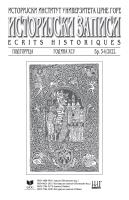O novcu grada Drivasta tragom jedne numizmatičke beleške
ON THE CURRENCY OF THE TOWN OF DRIVAST FOLLOWING A NUMISMATIC CLUE
Author(s): Marina OdakSubject(s): History, Cultural history, Local History / Microhistory, Middle Ages
Published by: Историјски институт Црне Горe
Keywords: municipal currency; Ulcinj-type follaro; Drivast-type follaro; city walls depictions on coins; iconography; Dubrovnik mint; Milče the goldsmith
Summary/Abstract: Since the important works on the municipal currencies of the towns on the southern part of the East Adriatic coast – including the currency of the town of Drivast were published in the journal Numismatische Zeitschrift in the early 20th cen- tury by the Austrian numismatist Karl Stockert, and whereas more recent papers on this topic tend to be rare, our attention was drawn to a paper by Sergije Dimitrijević, A New Series of New Types of Serbian Medieval Coins [Нова серија нових врста српског средњовековног новца], published in the journal Starinar [Старинар] in 1964–1965. In this paper, dealing with the follaro coin from the town of Ulcinj, with a depiction of the Virgin Mary with Christ on the obverse, and a depiction of the city walls with a tree in the gate on the reverse, Dimitrijević also mentions a subtype of this follaro, with a human figure with its arms and legs apart standing in the city gate. The paper states that one specimen of this follaro is kept at the Museum of Slavonia in Osijek. Dimitrijević also states in the paper that a similar type of folla- ro was minted by the town of Drivast. Following this clue, we contacted colleagues from the museum Museum of Slavonia in Osijek, to find the specimen mentioned by Dimitrijević, but no such coin was found. we have come to the conclusion that the currency in question is not a follaro from Ulcinj, but from Drivast. After a care- ful iconographic analysis of both follaro coins, we are of the opinion that our experi- enced numismatist misattributed the follaro in question, due to the striking similarity in the execution of the depictions on the obverse and reverse of the coins, some de- tails of which are identical. The coin moulds for both coins were clearly produced by the same artisan, whom we suspect to be Milče, the goldsmith from the Dubrovnik mint, who was authorised by the Ragusan Minor Council in 1386 to cut the moulds for Ulcinj’s coinage.
Journal: Историјски записи
- Issue Year: 3/2022
- Issue No: 4
- Page Range: 25-41
- Page Count: 16
- Language: Montenegrine

